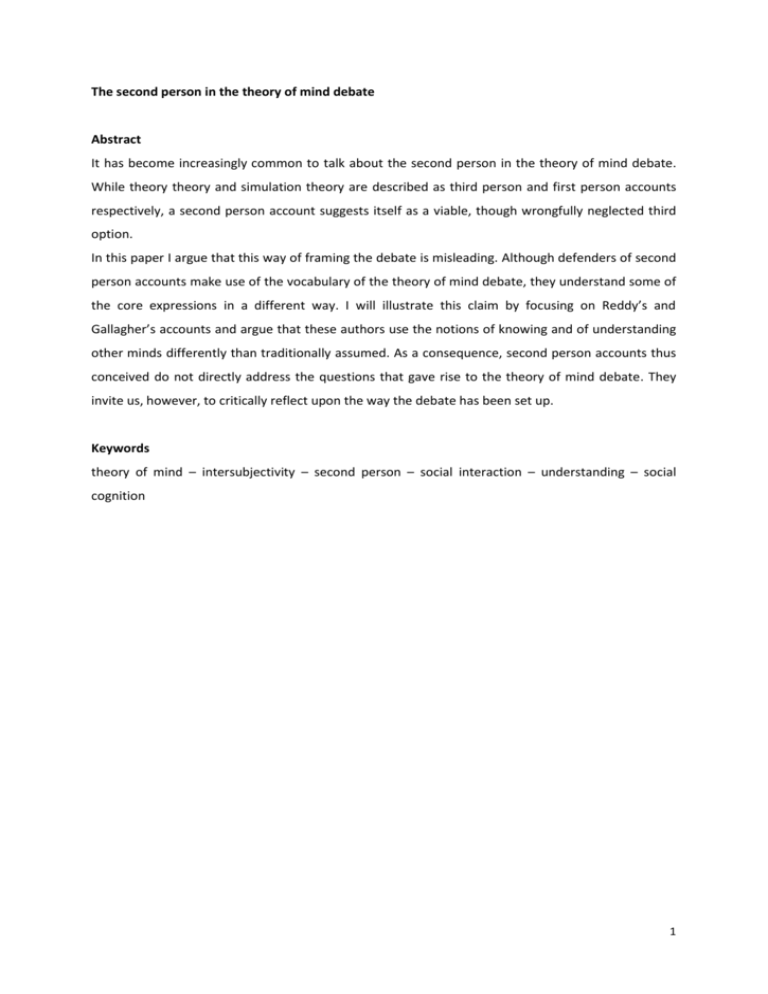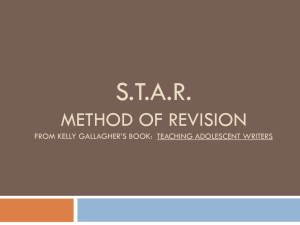The Second Person in the Theory of Mind Debate
advertisement

The second person in the theory of mind debate Abstract It has become increasingly common to talk about the second person in the theory of mind debate. While theory theory and simulation theory are described as third person and first person accounts respectively, a second person account suggests itself as a viable, though wrongfully neglected third option. In this paper I argue that this way of framing the debate is misleading. Although defenders of second person accounts make use of the vocabulary of the theory of mind debate, they understand some of the core expressions in a different way. I will illustrate this claim by focusing on Reddy’s and Gallagher’s accounts and argue that these authors use the notions of knowing and of understanding other minds differently than traditionally assumed. As a consequence, second person accounts thus conceived do not directly address the questions that gave rise to the theory of mind debate. They invite us, however, to critically reflect upon the way the debate has been set up. Keywords theory of mind – intersubjectivity – second person – social interaction – understanding – social cognition 1 1. The second person in the theory of mind debate It has become increasingly common to talk about the second person in the theory of mind (ToM) debate. Starting off with two commentaries on a target article in Behavioral and Brain Sciences in 1996,1 the debate has recently seen a proliferation of terms such as “second person interaction” (Gallagher 2001), “second person(al) context” (Hutto 2004), “second person stance” (Ratcliffe 2006), “second person relationship” (Gallagher 2004), “second person access” (Zahavi 2007), and “second person perspective” (Gallagher 2009; Schilbach 2010). The spirit in which these notions are typically used is a critical one. The two dominant approaches, theory theory (TT) and simulation theory (ST), are criticized for assuming a spectatorial stance. This means that these accounts focus exclusively on situations in which another person is talked about in the third person mode, but neglect – and do not do justice to – situations in which another person is addressed directly in the second person mode. But authors such as Gallagher (2001, 2004, 2005, 2008) and Reddy (2003, 2008) have not contented themselves with this critique, they also used it as a springboard for developing alternative proposals to ST and TT. Whereas Reddy calls her proposal explicitly a second person approach, Gallagher’s suggestions, developed over a time span of now ten years, came to be called interaction theory (IT). Both accounts share the two following features: First, they are explicitly presented as alternatives to TT and ST (e.g. Gallagher 2001, p. 85; Reddy 2008, p. 7). They are framed in the vocabulary of the ToM debate and promise to give answers to the questions at issue. Second, both accounts are said to avoid the so-called first and third person routes to other minds (i.e. to understand others by either starting off from one’s own mental experiences as ST does or from folk psychological theories as TT does) by taking the second person as a point of departure. Second person accounts thus seem to be the new, though wrongfully neglected third option besides ST and TT. While the appeal to the second person is becoming a marked trend in the debate, its potential merits are obscured by the fact that the notion of the second person tends to be used inconsistently and in service of different research programs. The aim of this paper is thus to critically review and evaluate Reddy’s and Gallagher’s second person accounts by giving a detailed reconstruction and comparison of their arguments. The paper has both a negative and a positive message. The negative is: Neither Reddy’s nor Gallagher’s approach convinces as an alternative to ST and TT because neither approach provides answers to the questions at issue in the ToM debate. Although both authors frame their proposals in terms that sound familiar to the debate, they understand some of the core expressions in a different way. In particular, I will make a case for the claim that Reddy does not use the notion of knowing other minds in the traditional sense in which it means having a justified true belief about 1 The target article was written by Barresi and Moore (1996), presenting a four-level framework for the developing understanding of intentional relations. Independently of each other, two psychologists critically pointed out that the authors neglected second person intentional relations which they describe as “involving the perception of an activity performed by another organism upon the perceiver” (Gomez 1996, p. 129f.) or relations that are “involved in self toward the other and in the other toward the self” (Reddy 1996, p. 140). 2 other minds. Similarly, I argue that Gallagher does not use the notion of understanding other persons in the traditional sense in which it means understanding them in terms of mental states. Both Reddy and Gallagher ultimately have different explananda in mind than defenders of ST and TT. The positive message is: If these explananda are taken seriously and explicated in a far more systematic way than it has been done up to now, they point to some very specific limitations of the ToM framework. The plan of the paper is as follows: In the following section 2 I will give a short introduction into what the ToM debate is about. The aim is to lay bare the various questions to which ST and TT, as Goldman has stated, seem to be the “only two games in town” (Goldman 1995, p. 191). On that background, I reconstruct and evaluate Reddy’s and Gallagher’s proposals in sections 3 and 5. While these two sections provide the arguments for the negative message of the paper, sections 4 and 6 should be seen as the constructive part. In section 4 I argue that Reddy’s account regains force and persuasiveness if it is compared to the position Cavell holds in regard of the classic problem of other minds. The intuitions which Cavell tried to capture under the label of acknowledgement are, I claim, precisely the ones which motivate Reddy’s line of reasoning. Similarly, I explicate in section 6 the kind of interpersonal understanding which Gallagher aims at with his interaction theory. The conceptual work I present in these two sections goes far beyond what Reddy and Gallagher say and is, as an interpretation of their work, necessarily speculative. Taken independently, however, the ideas presented here can be seen as an attempt to widen the theoretical landscape beyond the ToM framework. In the concluding section 7 I will reconnect these ideas to the ToM debate and point to some “blind spots” which they bring into view. 2. The theory of mind debate The contemporary ToM debate is an interdisciplinary debate that involves not only philosophers of different backgrounds, but also psychologists and neuroscientists. This is what makes the debate most attractive, but also imposes its greatest risk: the risk to talk cross-purposes. In order to lay bare the core questions that gave rise to the debate, let us go back to the origins of the term “theory of mind”. As it is well known, the phrase was coined by the animal psychologists Premack and Woodruff who defined: “In saying that an individual has a theory of mind, we mean that the individual imputes mental states to himself and others […].” (1978, p. 515), and who explained their usage of the term “theory” as follows: “A system of inferences of this kind is properly viewed as a theory, first, because such states are not directly observable, and second, because the system can be used to make predictions, specifically about the behavior of other organisms.” (1978, p. 515) 3 This explanation is telling because it reveals that Premack and Woodruff started off with certain assumptions, certain platitudes of cognitive psychology at the time: They explicitly refer to the nonobservability of mental states and their contrast to behavior. It additionally seems very plausible that they had a rather specific conception of mental states in mind according to which mental states are relations between organisms and mental representations.2 Furthermore, Premack and Woodruff assume that the main function of the ascription of mental states is the prediction of behavior. Until recently, this assumption has been taken for granted by most researchers in the field, at best added by a second function, the explanation of behavior. Whereas Premack and Woodruff originally based their claims for a chimpanzee’s theory of mind on its alleged ability to ascribe intentions, the discussion that evolved around their paper cemented the long-lasting focus of the debate on the ascription of beliefs. The term “theory of mind” became the “agreed label” (Perner 1999, p. 205) for a field in developmental psychology with two symposia on children’s understanding of false beliefs which took place in 1986. Some of the main figures in this rapidly growing field further developed Premack and Woodruff’s suggestions into the approach that came to be called theory theory. This approach was originally thought to give an answer to the question as to how and why children start thinking about human behavior in terms of mental states. 1986 was also the year in which the long-lasting rival to theory theory, simulation theory, found its first formulations in papers by Heal (1986) and Gordon (1986). In contrast to defenders of TT, these authors were not so much interested in the general question of how we come to understand humans in terms of mental states, but rather in the cognitive mechanism that underlies the attribution of specific mental states. The attribution of mental states, they argue, does not involve a folk psychological theory, but is rather based on a simulation process. What can be learnt from this detour into the history of the ToM debate is the following: First, the overall explanandum – theory of mind – is meant to refer to a specific ability of ours, i.e. to form judgments about ourselves and others which concern their or our feelings, beliefs, intentions, desires etc.3 Second, researchers in the field try to answer two different questions, namely, How, generally, do we arrive at an understanding of ourselves and others as psychological beings, i.e. as organisms who have mental states? 2 As Fodor (1975) has argued, cognitive psychologists’ theorizing at that time implied such a conception which he famously called a representational theory of mind. Premack and Woodruff do not refer to Fodor’s work, but it seems to be more than a coincidence that they use the very same expression as Fodor does. 3 I am referring here to what is commonly known as explicit (in contrast to implicit) theory of mind abilities. Butterfill and Apperly (ms.) explicate this contrast by distinguishing between theory of mind cognition (which paradigmatically involves the ascription of propositional attitudes) and theory of mind abilities (which are the basis for “exploiting or influencing facts about others’ mental states” (p. 3, ms) but without necessarily representing them as such). The last years have seen an explosion of empirical studies on implicit theory of mind abilities (see Sodian 2011 for an overview). However, this area of research is not particularly relevant in the context of this paper because a) the theoretical interpretation of these results is still under discussion, b) these studies (and their interpretation) do not play a systematic role for the arguments to be reviewed here. 4 How, specifically, do we come to know the mental state we and others have? Third, the debate was from its very beginning shaped by certain preconceptions about the nature of mental states. These preconceptions gave rise to the ubiquitous talk about imputing, attributing, ascribing or inferring mental states for which, ironically, the term “mindreading” was coined (Costall et al. 2006). Exactly these assumptions came under attack in recent years, especially but not uniquely by authors standing in the phenomenological tradition (e.g. Gallagher and Zahavi 2008, chapter 9; Leudar and Costall 2009). They take the contrast between (observable) behavior and (unobservable) mental states to be a methodological artifact, argue against a conception of mental states as involving mental representations, advise to focus on the understanding of emotions and intentions (rather than on false beliefs), and plea for the observability of precisely these mental states. Although these criticisms do not doubt the legitimacy of overall ToM framework, they should make us very cautious in talking about theory of mind abilities. In order to avoid misleading connotations I will in what follows work with a slightly modified definition of theory of mind as the ability to understand others in terms of mental states. This makes it clear that we have a theory of mind when we are able to form judgments about feelings, beliefs, intentions etc. The definition is, however, neutral in regard of any specific preconception about the nature of these states. While the notion of the second person sometimes shows up in the context of these arguments, it is, as we will see in what follows, tied to a second, more radical strand of criticism of the ToM framework. 3. Reddy’s second person account The developmental psychologist Vasudevi Reddy was one of the first to introduce the notion of the second person into cognitive psychology (see footnote 1). In her commentary on Barresi and Moore’s article she criticizes the exclusive focus on first and third person information only, and points to the neglect of so-called second person information, i.e. information which, in her view, only becomes available “whenever a person is in emotional engagement (in a broad attitudinal way) with a second person” (1996, p. 140). In her book “How infants know minds” from 2008, Reddy tailors this criticism to the ToM debate and develops an alternative account to both TT and ST which she calls the second person approach to other minds. But what precisely is meant by the notion of engagement which Reddy puts in the center of her positive account? And what role does the second person play which serves as the eponym for her approach? Taken literally, the notion of the second person indicates that a speaker addresses a second person with the personal pronoun “you”. It thus describes a certain social constellation, a social address which, if the addressee responds, develops into a social interaction. Reddy, however, goes beyond that when she explains: 5 “The second person voice captures a fundamentally personal engagement going beyond the mere use of the “You” to something in the psychological regard and openness – and intimacy – of the speaker to the listener.” (2008, p. 28) Reddy thus has not only a social constellation in mind, but, in addition and in reference to ideas expressed by Martin Buber (1937) and Mikhail Bakhtin (1986), a certain attitude which the speaker and the listener can, but need not adopt in regard of each other. As she mentions herself, there are social interactions which bare this form of personal involvement, for example when someone is addressed as a member of a category or, even worse, treated as an object. But whenever two persons are emotionally engaged in this way – and this is Reddy’s core claim – information about oneself and about the other is intertwined: “When the “other” whom we are perceiving is someone we are engaged with in a second person exchange, the gap between third-person perception and first-person proprioception is even more implausible. […] Within active emotional engagement your perception of the other always involves proprioceptive experience of self-feelings-for-the-other, and your proprioception of the self always involves perception of other-feelings-for-self.” (2008, p. 30). Whereas the classic approaches of ST and TT assume a strict distinction between first person information about oneself and third person information about the other, emotional engagement allows the simultaneous experience of both self and other. This kind of information is, she claims, qualitatively different from both first and third person information and allows me “to know you in a way that I do not know you when I am merely watching you” (2008, p. 30). Let us look at an example to better understand what Reddy aims at: Imagine presenting your ideas to your supervisor. While you talk, she glowers at you. You feel disturbed, lose confidence in what you say, and hesitate. You experience her as being very critical, maybe even offensive. This illustrates the first point Reddy wants to make: The way you come to see another person is very much influenced by your own emotional reaction in regard of her. You see the other, as Reddy quotes from King Lear, feelingly. Similarly, the way you experience yourself is shaped by the other’s reaction – had the supervisor smiled at you instead of glowered, you would have probably experienced yourself in a much more positive light. Emotions, or rather the emotional reactions in regard of one another, provide, as Reddy puts it, the link between two persons that the ToM debate has neglected up to now. The phenomena Reddy points to are well-known and hard to deny. Emotions do shape the way we experience each other. But the question is as to whether these phenomena help us to give new answers to the questions which the ToM debate is about: Do they allow us to acquire knowledge about the other’s feelings or beliefs? And / or do they help us to understand why we think of other 6 persons as having mental states at all? Let us have a look at these questions one after another.4 First, what could I come to know about my supervisor when I react emotionally in regard of her? Do my experiences really provide knowledge about her? I am worried here about a specific limitation of Reddy’s line of reasoning which comes into view once one accepts that talking about knowledge means (at least in a standard reading of the term which the ToM debate has adopted from analytic epistemology) talking about justified true beliefs: My emotional reactions and consequently the way I experience another person are not only influenced by what the other person does, but also by the situation, our relationship and, finally, my own concerns and personality. Another student in the above-mentioned situation might cope very differently with the supervisor’s frown. He might, for example, immediately ask her to explain it, appreciate the comment, and experience the supervisor as helpful and engaged. There is no possibility to decide who is right and who is wrong about the supervisor, no way to disentangle the “subjective” aspects from “objective” ones and, consequently, no way of rationally justifying one’s impressions. Defenders of the two classic approaches are, by contrast, better off at this point. Asked about the reasons for holding a belief about another person’s mental state, they can either resort to some general folk psychological principles (TT) or to the fact that we all have a sufficiently similar cognitive and emotional apparatus (ST). Given these complications, one has reasons to suspect that the primary explanandum of Reddy’s second person account is not so much our specific knowledge about others’ mental state, but rather the general knowledge that others have mental states at all. Returning to the example with the supervisor, it seems as if – although we both perceive the supervisor differently – neither of us would doubt that the supervisor has a mind at all. In responding to her frown, no matter how, we both have already taken her as a person that thinks, wants and feels. Reddy could thus be understood as claiming that one’s emotional reactions in regard of a second person somehow reveal our knowledge that this second person has a mind at all. But, again, the usage of the term “knowledge” seems to be misplaced here. The mere fact that the supervisor is perceived and treated as a person does not prove that she actually is one. The mere fact that we react in a certain way does not justify our doing so. We might, for example, also feel a mixture of anger and helplessness in regard of our malfunctioning computer, but this does not make it a person. I conclude from this discussion that Reddy’s second person account does not hold what it promises: It does not give new answers to the classic ToM questions of how to know the nature and the existence of other minds. I suspect, however, that this was not her ultimate aim either. I suspect that, when she titled her book “How infants know minds”, she was not thinking of justified true beliefs about other minds. Rather, she might have either been thinking of a different sense of knowing minds – a sense which does not 4 The two questions are set apart here for the sake of clarity. In any particular situation, they are of course intimately connected. 7 involve propositional knowledge about other minds, but refers to some form of acquaintance with them –5, or of acknowledging other minds. Both suggestions call for a detailed explanation which is beyond the aims of this paper. In what follows, I nevertheless want to sketch what I mean by the latter (and more radical) suggestion, leaving the first one for another opportunity. 4. Knowing and acknowledging The title of this section is taken from an article of Stanley Cavell from 1967, and this is no coincidence: I want to propose that Reddy’s second person account regains force and persuasiveness if it is compared to the position Stanley Cavell holds in regard of the classic problem of other minds. In the just mentioned article Cavell presents, among other things, a diagnosis of the problem of other minds as it has plagued analytic philosophers especially in the 20th century. In what could be called a philosopher’s psychology of philosophers Cavell first points to the phenomenon which, in his view, motivates any skeptical argument concerning other minds: The fact that one cannot feel another’s feelings or think another’s thoughts. This fact impresses the skeptic because it opens up the possibility that “I may be suffering when no one else is, and that no one (else) may know (or care?); and that others may be suffering and I do not know, which is equally appalling.” (1976, p. 247). However, in trying to explicate this insight, the skeptic introduces two further assumptions which, according to Cavell, distort the original phenomenon and in the end lead to an unsolvable problem of other minds. First, the skeptic stops, as we usually do, treating another’s behavior as expressive. Instead, being intrigued by the possibility of simulation, he takes behavior to be a mere indicator of mental states, loosely associated with it. This separation naturally leaves him wondering about reasons for being certain that another’s behavior in fact expresses his mind. Second, he contrast this question (“How do I know (am certain) that another is in fact e.g. in pain?”) with the first person case, claiming that we do not have any problems in being certain about our own mental states (“I always know (am certain) about my own pain.”). Thus set up, the original phenomenon has become an epistemic problem, a problem of knowledge. Cavell’s diagnosis directly echoes Reddy’s way of framing the ToM debate (Reddy 2008, chapter 2). More importantly, however, Cavell also proposes to turn to the second person case to get over the problem thus conceived. Reflecting on the second person case should make us aware, he suggests, that the reading of the verb “to know” as “to be certain” is highly unusual if it is combined with an expression for mental states. As an example, Cavell uses the case of pain and explains: “I might say here that the reason “I know you are in pain” is not an expression of certainty is that it is a response to this exhibiting [of pain by another person, MD]; it is an expression of sympathy. […] But why is sympathy expressed in this way? Because your suffering makes a 5 Thanks to my anonymous reviewers for this suggestion. 8 claim upon me. It is not enough that I know (am certain) that you suffer – I must do or reveal something (what ever can be done). In a word, I must acknowledge it, otherwise I do not know what “(you or his) being in pain” means.” (1976, p. 263). This short and dense paragraph summarizes Cavell’s position with several relevant aspects to focus on for our discussion. In short, Cavell proposes that the problem of other minds is wrongly portrayed as an epistemic problem, i.e. as a problem of certainty, because the term “to know” should not be read as an expression of certainty. Whenever we utter sentences such as “I know I am / you are / he is in pain” we usually express the fact that we acknowledge our own or another’s pain. This means that we do not stay indifferent, that we take it seriously and act accordingly. Although the way we acknowledge our own and another’s pain is different – in the first case we simply express it, in the second case we react to the expression –, the task is similar and far from creating a problem that would be peculiar to other minds (as the epistemic version has it). Finally, if we fail to acknowledge either our own or another’s pain, we risk to end up in the separateness from which according to Cavell the skeptic started off: the terrifying situation in which we (or another person) suffers and nobody else knows and cares. When comparing Cavell’s account to Reddy’s, some differences can hardly be ignored. Cavell does not point to the neglect of emotions and he does not introduce a special sort of second person information which – as Reddy tried to argue – allows us to know other minds. More importantly, Cavell does not even claim to give an answer to the classic problem of other minds, but makes it explicit that a focus on the second person leads to a reconceptualization of the problem. By doing so, he avoids the problems that beset Reddy’s account. Cavell’s notion of acknowledgement even provides, I suggest, a more appropriate theoretical frame for the phenomena Reddy ultimately aims at. The emotional reactions Reddy points to could be seen as different ways of responding to the claim Cavell has talked about, i.e. as different forms of acknowledging another’s expressions. For both authors, these reactions are to be done in a certain spirit: They presuppose an attitude towards the other person according to which he or she is actually seen and treated as a person.6 This attitude is not something that could be rationally justified, but it is the basis and precondition for interpersonal relations. Reddy comes closest to this when she argues against the framework of doubt besetting the ToM debate: “If we really lived within a framework of doubt we could never function, never really be open to engagement. We need, if not certainty, at least the absence of uncertainty in order to do things with other minds.” (2008, p. 13) 6 Cavell refers in this context to Wittgenstein’s notion of an attitude towards a soul (1976, p. 240, and more prominently in his book from 1979, pp. 338-361). 9 With Cavell’s words in mind, this quote could be interpreted as stating that Reddy, too, does not aim at giving reasons for being certain about the existence and the nature of other minds. What emotional engagements offer is a different sense of knowing other minds – a sense which, following Cavell, could be described as acknowledging other minds. 5. Gallagher’s critique of ST and TT Whereas Reddy is standing in the tradition of dialogical philosophy, another group of authors, all from a broadly phenomenological background, have increasingly made use of the notion of the second person. Gallagher has, partly in cooperation with Zahavi and Hutto, developed over the years another alternative to both ST and TT, interaction theory (IT). Given that this theory arose out of a critique of ST and TT for not doing justice to so-called second personal contexts, let us first have a look at this critique. Gallagher summarizes the basic intuition as follows: “In the situation of talking with someone else about a third person, it seems possible to describe our attitude toward the person under discussion as theoretical or as involving a simulation of the other person’s mental states. But does the same description capture the dynamics of our interaction with our interlocutor? This is, in a second person conversational situation […] our process of interpretation does not seem to involve a detached or abstract, third-person quest for causal explanation.” (2001, p. 93) This quote makes it clear that Gallagher’s critique is based on the distinction between talking about another person and talking with her. He associates these two situations with the labels “third person” and “second person” respectively because the corresponding pronouns are used. However, Gallagher does not restrict himself to talking about conversations only. Rather, the label “second person” is meant to capture all kinds of social interactions (2008, p. 164f.). But what characterizes a social interaction? In a recent paper, one finds Gallagher and colleagues stating that what is essential to social interaction is not only the reciprocal and dynamical responding between the individuals, but: “Essential to interaction is that it involves engagement between agents. The notion of engagement […] is meant to capture the qualitative aspect of social interaction once it starts to ‘take over’ and acquires a momentum of its own.” (de Jaegher et al. 2010, p. 442). In explicating the notion of the second person, Gallagher thus turns to the very same term as Reddy does, to “engagement”. Whereas Reddy takes, however, (emotional) engagement to stand for a certain attitude which interacting partners might adopt with respect to each other, Gallagher refers to this term to emphasize the autonomy of social interactions, i.e. the fact that interactions are more than the summation of individual attitudes and actions. 10 This notion of a second person interaction is used in an argument by which Gallagher attacks the socalled “supposition of universality” (2004, p. 200, or “strong pragmatic claim” in 2001, p. 84) which he attributes to defenders of both ST and TT. In detail, this argument can be reconstructed as follows:7 (P1) A theory of intersubjectivity should describe our ordinary and pervasive way of understanding another person. (2001, p. 84) (P2) Ordinarily and for the most part we understand another person when we interact with her (= second person interaction). (2001, p. 85 & 93) (P3) Simulation theory and theory theory do not capture the way we understand another person while interacting with her. (2001, p. 93ff.) (C1) Simulation theory and theory theory “at best, explain a very narrow and specialized set of cognitive processes” for understanding others. (2001, p. 85) (P2&P3) (C2) Simulation theory and theory theory do not convince as theories of intersubjectivity. (C1&P1) As the argument seems to be valid, let us look at the premises. The first premise specifies the task researchers in the field are meant to accomplish. It specifies their explanandum. On the background of the ToM debate, the most natural way to read this premise is to read it in such a way that “understanding another person” means coming to know what another person thinks, feels, wants, etc. Understood in this way, defenders of both ST and TT will agree that this is one of the tasks their theories are meant to achieve. The second premise describes the situation in which this kind of understanding – allegedly – takes place most of the times: a second person interaction. Why is this situation an important one to mention? One might suspect that Gallagher is particularly interested in it because he endorses an enactive account of cognition according to which cognition is situated. This, generally speaking, means that the context in which certain cognitive abilities are called for is not to be neglected because it influences the way cognition works. But is Gallagher right in claiming that we typically try to understand other persons when interacting with them? Far from being obvious, this first and foremost seems to be an empirical question.8 Of course, we are sometimes interested in our interacting partner’s feelings and thoughts, and we sometimes think or even talk about them. Being involved in a common project or a conversation about any other topic, we can, however, also simply be focused on what we are working on or talking about. What, then, makes Gallagher to be as convinced of his premise that he does not even provide reasons for it? The way he understands his premise is, I believe, more obvious in the slightly different formulation: 7 Gallagher repeated and refined this argument at various places. I will focus on the original version from the article in 2001, but point to relevant changes that have been made in what follows. 8 Thanks to Uko Tooming and Andrea Lailach-Hennrich for drawing my attention to this point. 11 (P2’) Ordinarily and for the most part we encounter another person when we interact with her (= second person situation). (2004, p. 204) The answer might thus lie in Gallagher’s usage of the term “to understand another person”. If Gallagher takes this term in (P2) to mean something like meeting or engaging with others, the premise is much more plausible.9 But, of course, the problem would then be that no conclusions could be drawn from combining (P1) with (P2) because the two premises presuppose two different readings of one single term. It is precisely this oscillation between different meanings of the notion of understanding others which – as I want to show in what follows – makes Gallagher’s critique and his positive account so hard to pin down. At some places, Gallagher adopts the traditional notion (i.e. understanding others in the sense of having beliefs about their mental states) and seems to think – similarly as Reddy – that social interactions are a new and up to now overlooked means of coming to know other minds. At other places, Gallagher presents himself as being more radical and seems to generally contest the importance of understanding others in terms of their mental states. In this section, I will focus on the more radical strand in Gallagher’s work according to which understanding others – or intersubjective understanding as he calls it in later publications (e.g. 2004, p. 204) – means something like engaging with others or relating to them. This notion is, I believe, also at play in (P3) in which Gallagher states that ST and TT do not do justice to the way we understand others while interacting with them. He offers two different reasons to support this claim. First, he (rightly) states that paradigm cases for ST and TT are situations in which we observe other persons. The ToM debate has been heavily influenced by experimental paradigms which, until recently, have mostly been third-personal.10 A first, rather weak conclusion one could draw from this observation is the following: What defenders of ST and TT have not provided up to now is the proof that their theories are externally valid. Given that their theories have been developed on the basis of thirdpersonal experimental results it remains to be seen whether they are also of relevance when it comes to situated social cognition, i.e. when the task is to understand other persons in direct social interactions. With his second argument, Gallagher anticipates and criticizes a possible reply to this challenge on behalf of ST and TT. Gallagher assumes that defenders of ST and TT would claim that the principal aim of social interactions is, similarly as in third-person observation, the prediction and explanation of another’s behavior on the basis of mental state attribution. He, by contrast, points out that phenomenology tells us that social interactions are better characterized by “something like evaluative understanding about what someone means or about how I should respond in any particular situation” (2001, p. 94). Gallagher’s strategy is in my view not entirely fair to defenders of 9 This suspicion is reinforced by the fact that Gallagher typically uses the notion of understanding others in contexts in which he also talks about engaging with others and relating to them (e.g. 2005, p. 208). 10 This means that the person who participated in the experiment was merely observing what other persons or animated agents where doing, but was not interacting with them. The (explicit or implicit) task was then to either explain or predict what the observed persons or agents were doing. 12 ST and TT. I think that they would not have any problems in giving up the idea that theory of mind abilities serve the explanation and prediction of behavior only. Rather, they could add that they are also of use for precisely the aims Gallagher describes as being typical for social interaction. The choice of an appropriate action might, for example, essentially depend upon the knowledge we have about the other person’s beliefs or feelings. The crucial claim defenders of ST and TT would, however, maintain, is the claim that understanding others involves forming judgments about their mental states because this is as I have tried to show in section 2 what the debate is about. This, however, seems to be exactly the view which Gallagher wants to deny in his ideas of evaluative understanding and pragmatic interaction. His intention is most obvious in the way he explains these ideas by appealing to Heidegger’s example of the carpenter’s hammer: The carpenter typically does not treat the hammer as an object, as something to be judged or explained. He deals with the hammer on a pragmatic level and simply uses it as an instrument. In a similar vein, Gallagher claims, “one’s relation to others is not primarily theoretical or conceptual, but is first of all an interactive one” (2001, p. 94, note 11). The point Gallagher tries to get at in (P3) is thus the following: ST and TT do not capture the way we understand others in social interactions because we usually do not even try to understand them in terms of their mental states. We do not form judgments about them, we do not think about them we simply try to keep the interaction going (or to end it) by responding to them. This view is also echoed in Gallagher’s later remark: “What we call social cognition is often nothing more than social interaction. What I perceive in these cases [in ordinary social interactions, MD] does not constitute something short of understanding.” (Gallagher 2008, p. 540) which de Jaegher interprets as: “This is a clear claim to the effect that social interaction often is social understanding.” (de Jaegher 2009, p. 537) Before raising some worries against this view and turning to an alternative interpretation of interpersonal understanding in the next section, let me end by pointing out the consequences of this reading for the overall argument against ST and TT. If my interpretations of the second and the third premise are on the right track, Gallagher has in these two premises a different concept of understanding others in mind than the one that is taken for granted in the ToM debate. The argument would thus not be valid if, as we assumed at the very beginning, this traditional notion of understanding is read into the first premise. The argument convinces, by contrast, if understanding others basically means engaging or interacting with them throughout the whole argument. But the problem then is that Gallagher starts off with a different explanandum than the two traditional 13 theories in the debate. In contrast to how Gallagher reads the debate,11 neither TT nor ST was originally developed with the aim of giving an account of how social relations are established or of how social interactions work. Defenders of both theories have, as our detour into the history of the debate in section 2 was meant to show, focused on a very specific aspect of social cognition, the understanding of others in terms of their mental states. It might well be that they have, in their enthusiasm for the ToM framework, overemphasized the importance of this aspect. And it might well be that the intensive research which this framework has attracted leads one to assume that theory of mind is “all there is” to social cognition or intersubjectivity more generally. Gallagher is right to oppose to these impressions, but this does not change the legitimacy of the primary explanandum of both ST and TT. 6. Intersubjective understanding As already indicated, Gallagher’s work is difficult to interpret because he oscillates between different notions of understanding others. In the previous section, I have focused on Gallagher’s argument against ST and TT and claimed that it would be valid if “understanding others” means more or less interacting with them. In this section, by contrast, I will bring forward various reasons which speak against an unqualified identification of understanding others with social interactions. I will introduce an alternative reading of Gallagher’s work which has been proposed by Ratcliffe and use his insights to explicate a different sense of intersubjective understanding. This suggestion allows me to finally situate and value the contribution Gallagher’s interaction theory makes to the ToM debate. A first point is rather verbal. If we follow the line of reasoning of the previous section, Gallagher ultimately aims at a different explanandum than defenders of ST and TT. He seems to be interested in interactional phenomena such as e.g. interaction patterns and alignment in speech and gestures, and he is right to point out (as in de Jaegher et al., 2010) that these phenomena have long been a neglected area of research in social psychology. But the crucial question is whether he is right to call these phenomena intersubjective understanding given that, intuitively, intersubjective coordination seems to be the more adequate term. Of course, the notion of understanding is notoriously ambiguous and nobody can prevent one from defining it in just this sense.12 But it seems clear that whenever this notion is used in the context of the ToM debate it implies – in contrast to the notion of coordination – a certain focus: a focus on the other person. At same places, Gallagher endorses precisely this aspect, e.g. when he characterizes the task which ST, TT, and IT are meant to accomplish as follows: 11 This reading is most obvious in e.g.: “I outline the case against theory of mind as an account of our everyday normal interaction with others.” (2004, p. 201). 12 For an illuminating analysis of the varieties of meanings of the ordinary German term “verstehen” see e.g. Strube (1985). 14 “[…] is centered on the following question: How do we understand another person?” (2009, p. 297) The target, as Gallagher puts it later on, is the other person, and the aim of all these theories is to describe how we understand her. Ratcliffe’s (2006) interpretation and elaboration of Gallagher’s work does justice to this intuition. Instead of identifying interpersonal understanding with social interactions, social interactions in his view should be thought of as being constitutive for understanding. Ratcliffe explains this idea as follows: “Examples of interaction illustrate that interpersonal understanding is not always phenomenologically describable as A attributing internal states to B or even A interpreting B. It is constituted by the interaction between them. B is not just interpreted by A but is also constitutive of the process through which A interprets A, B and the relationship between them. “ (2006, p. 40) As I read this passage, Ratcliffe finds fault with what could be called a structural feature of understanding another person as it is traditionally conceived. Relying more or less exclusively on third-personal situations, defenders of both ST and of TT assume that understanding another person is a solitary task: One person – let us call her the epistemic subject – gathers and interprets the information which another person – let us call her the epistemic object – provides, be it intended or not. Ratcliffe, by contrast, points out that social interactions call for a more collaborative conception of understanding. Interpersonal understanding is to be conceived as a common project which is not only shaped by all the interacting persons, but also by the way the interaction unfolds itself.13 This intuition is captured prominently in German by the distinction between the terms Verstehen (to understand something or someone) and Verständigung (to reach a mutual understanding with someone about something or someone).14 Whereas Verstehen is a two-place relation between an epistemic subject and its object, Verständigung is a three-place relation. The two (or more) persons involved stand on an equal footing here. They are partners who – through their interaction – come to agree about a certain subject matter. Although Verständigung implies that a certain result – called Einverständnis (mutual understanding) in German –, a strong emphasis lies on the process by which this result has come about. Reaching a mutual understanding about a certain topic is thus more than having similar beliefs about it. It implies that the involved persons have on the basis of social acts 13 Reddy’s remark, to be found in her very first piece on the second person, points to a similar line of reasoning: „Their approach [Barresi & Moore’s, MD] appears to assume, however, that social understanding can only ever exist in the individual in the form of representations and conceptual schemas. A worthy alternative location for understanding is in interaction between people.”(1996, p. 140). 14 In what follows I will use the German expressions instead of the more long-winded English translations. My understanding of the contrast between Verstehen and Verständigung profited a lot from remarks made in Waldenfels (1979). I am indebted to Michela Summa for this reference. 15 such as offering and accepting (or refusing), asserting and agreeing (or denying), and of asking and responding come to agree upon something which goes beyond what they could have achieved individually.15 Gadamer who famously developed his account of hermeneutics on the basis of an analogy to a conversation eloquently described this process as follows: "Hence reaching an understanding on the subject matter of a conversation necessarily means that a common language must first be worked out in the conversation. […] To reach an understanding in a dialogue is not merely a matter of putting oneself forward and successfully asserting one's own point of view, but being transformed into a communion in which we do not remain what we were" (2004, p. 378f.)16 Gadamer thought that Verständigung happens in the course of a conversation, i.e. is based on language. Following Waldenfels (1979), one might, however, also think of an implicit form of Verständigung as a cooperation in the course of which both partners tune themselves to each other such as e.g. in proto-conversations between mother and child. The development of a common language which Gadamer advances as a characteristic feature of the process of Verständigung could thus be taken in a metaphorical sense to describe the establishment of a common way of how to do things together. Before being able to use these ideas to propose an alternative interpretation of Gallagher’s notion of interpersonal understanding, there is, however, another qualification we have to make: Verständigung can be achieved about anything, about any topic, whereas understanding others implies a certain focus, a focus on the other person. As a way of combining this other-centeredness with the interactive character of the process of Verständigung I thus propose that Gallagher’s notion of interpersonal understanding should be conceived as a process in which two (or more) persons reach a mutual understanding in the just-described sense about one of the persons involved, about her pains, her feelings or experiences. This process need not be based on language; it might develop on the basis of mimics and gestures. I think that it is precisely this kind of interpersonal understanding which Gallagher’s interaction theory is meant to describe at different stages of a child’s development. Crucial to his theory is the claim that a child is able to use increasingly more and different resources to learn about the person 15 Note that these social acts – which do not necessarily have to be verbal, i.e. speech acts – all presuppose that the two (or more) participants address each other in the second person mode. I take this to be further evidence for the fact that Verständigung allows us to capture some of the essential ideas related to the notion of the second person. 16 In the original version: „Die Verständigung über eine Sache, die im Gespräch zustande kommen soll, bedeutet daher notwendigerweise, daß im Gespräch eine gemeinsame Sache erst erarbeitet wird. […] Verständigung im Gespräch ist nicht ein bloßes Sichausspielen und Durchsetzen des eigenen Standpunktes, sondern eine Verwandlung ins Gemeinsame hin, in der man nicht bleibt, was man war.“ (2010, p. 384) Whereas the standard translation of “Verständigung” is thus “reaching an understanding”, I chose the expression “reaching a mutual understanding” for the context of this paper because it additionally emphasizes the collaborative aspect of Verständigung. 16 with whom she is interacting. In particular, Gallagher proposes the three following steps (see e.g. Gallagher and Hutto, 2008): Whereas a baby in the first year of life relies exclusively on the expressions and gestures of the other person to tune in to her, she later on is able to take contextual information into account. This allows her to establish a meaningful link between the person and the environment and to engage in triadic interactions. Verständigung, to put it differently, now reaches beyond the immediate dyad and can, as e.g. in joint attention, concern the way the two persons agree to treat a third object (or person). Whatever the child comes to learn about the other person in these early embodied practices remains, however, implicit. By reacting in an appropriate manner the child provides evidence for the fact that she has understood the other person (in some respects at least), but she is not yet able to make the other person a topic of her talk, i.e. to talk with her about her. This explicit form of Verständigung arises in the third phase with the emergence of narrative competency. The better a child speaks, the more she is are able to co-construct her own and her interlocutor’s story with the involved feelings, beliefs, intentions and desires. 7. Conclusion The aim of this paper was to critically evaluate two second person accounts which are presented as viable, though wrongfully neglected alternatives to the two classic approaches in the ToM debate, TT and ST. In both cases, the appeal to the notion of the second person can be said to be a pars pro toto. Being addressed as “you” by another person is not a sufficient feature for the kind of situations both Reddy and Gallagher have in mind. Whereas Reddy associates with this label a social interaction in the course of which the participants are emotionally engaged, Gallagher takes this label to stand for an interaction which “acquires a momentum of its own” (de Jaegher et al. 2010, p. 442). The appeal to neither of these two features of a social interaction provides, however, answers to the questions which are at stake in the ToM debate, namely How, generally, do we know that we and others are psychological beings? How, specifically, do we know the mental state we and others are in? Reddy attempts to answer these questions by postulating a new kind of information – second person information – arising in the course of emotionally engaged interactions. As we have seen in section 3, this strategy does not convince as a strategy to justify knowledge claims. Gallagher, by contrast, does not even try to answer one of these questions. His arguments – both the negative ones against the ST and TT and his own positive account, IT – only make sense if one assumes that he uses the notion of understanding others in a different way than the traditional one. Once having accepted, however, that both Reddy and Gallagher ultimately aim at different phenomena than defenders of the two classic approaches, their second person accounts might regain force and persuasiveness if these phenomena are analyzed in greater detail. I have tried to 17 provide the beginnings of such analyses in sections 4 and 6. I am well aware that the descriptions of acknowledgement and interpersonal understanding which I have put forward are very sketchy. Already at this point, they allow, however, to see some specific limitations of the ToM framework and to bring certain neglected phenomena back into view. Cavell’s notion of acknowledgement reveals that the general skeptical question of how to know that (we and) others are minded creatures might be irrelevant to our daily interactions with others. We might not start out as scientists, dividing the social world into (mere) behavior and mental states. We might not wonder about possible ways of justifying our daily routines with others, but simply treat them as minded creatures from the very beginning on. the specific question of how to know the mental state another person is in might not be driven by a quest for certainty. In our daily interactions, we might content ourselves with some rather good guesses about the other which are more or less influenced by our own subjective aspects. The focus does not lie on how to justify our beliefs about the other, but on how to react in regard of the other. Reddy’s metaphor of a gap could thus be taken as a warning: The more we become interested in questions about knowledge and justification – and both ST and TT are approaches which arose out of such a theoretical context –, the further we move away from what we actually do with other persons in our daily lives. We risk ending up wondering about each other in intellectual curiosity instead of describing our daily practices with others. Interpersonal understanding, taken in the way in which I have suggested, can be seen as an attempt to come closer to this everyday practice because it describes what we actually do when we try to make sense of each other. If contrasted with the traditional notion of understanding another person, it emphasizes the fact that understanding another person is typically not a solitary task, but a social process. The way one person is understood is something on which the participating persons come to agree, and it goes beyond any kind of understanding which each of these persons might have had individually. the fact that persons should not be conceived in a static way. They are not black boxes with a fixed array of mental states which another person has to find out about, but they are persons who might change in the course of an interaction, persons who, together with others, coconstruct their own stories. There remains a lot of theoretical work to be done, but these conclusions also help us to see new directions for empirical work. Talking about one’s own mental states, for example, seems to me to be a rather neglected topic in the debate up to now. There are empirical tools to study such processes of Verständigung, e.g. conversation analysis, and there is research that is done with these tools, 18 though mainly in sociology and in linguistics. What is urgently demanded is to broaden the scope of the ToM framework in such a way that it is possible to situate these areas of research within the classic debate. References Bakhtin, M. M. (1986). Speech Genres and Other Late Essays (transl. by V. W. McGee). Austin, TX: University of Texas Press. Baron-Cohen, S. (1995). Mindblindness: An essay on autism and theory of mind. Cambridge, MA: MIT Press. Barresi, J., & Moore, C. (1996). Intentional relations and social understanding. Behavioral and Brain Sciences, 19, 107-154. Buber, M. (1937). I and Thou (transl. by R. G. Smith). Edinburgh: T. and T. Clark. Cavell, S. (1976). Must we mean what we say? Cambridge: Cambridge University Press. Cavell, S. (1979). The claim of reason: Wittgenstein, skepticism, morality, and tragedy. Oxford: Oxford University Press. Costall, A., Leudar, I., & Reddy, V. (2006). Failing to see the irony in ‘mind-reading.’ Theory & Psychology, 16, 163-167. De Jaegher, H. (2009). Social understanding through direct perception? Yes, by interacting. Consciousness and Cognition,18, 535-542. De Jaegher, H., Di Paolo, E., & Gallagher, S. (2010). Can social interaction constitute social cognition? Trends in Cognitive Sciences, 10, 441-447. Fodor, J. A. (1975). The Language of Thought, Cambridge, MA: Harvard University Press. Gadamer, H.-G. (2010). Wahrheit und Methode. Grundzüge einer philosophischen Hermeneutik (7th revised edition). Tübingen: Mohr Siebeck. Gadamer, H.-G. (2004). Truth and Method (2nd revised edition, translated by J. Weinsheimer and D. Marshall). New York: Continuum. Gallagher, S. (2001). The practice of mind: Theory, simulation, or interaction? Journal of Consciousness Studies, 8 (5-7), 83-107. Gallagher, S. (2004). Understanding interpersonal problems in autism: Interaction theory as an alternative to theory of mind. Philosophy, Psychiatry, & Psychology, 11(3), 199-216. Gallagher, S. (2005). How the Body Shapes the Mind. Oxford: Oxford University Press. Gallagher, S. (2008). Inference or interaction: social cognition without precursors. Philosophical Explorations, 11(3), 163-174. 19 Gallagher, S. (2008b). Direct perception in the intersubjective context. Consciousness and Cognition, 17, 535-543. Gallagher, S. (2009). Two problems of intersubjectivity. Journal of Consciousness Studies, 16(6-8), 289-308. Gallagher, S., & Zahavi, D. (2008). The phenomenological mind. An introduction to Philosophy of Mind and Cognitive Science. Abingdon: Routledge. Goldman, A. I. (1995). Empathy, Mind and Morals. In M. Davies & T. Stone (Eds.), Mental Simulation: Evaluations and Applications (pp. 185-208). Oxford: Blackwell. Gomez, J. C. (1996). Second person intentional relations in the evolution of social understanding. Behavioral and Brain Sciences, 19, 129-130. Gordon, R. M. (1986). Folk psychology as simulation. Mind and Language, 1, 158-171. Heal, J. (1986). Replication and Functionalism. In J. Butterfield (Ed.), Language, Mind and Logic (pp. 135-150). Cambridge: Cambridge University Press. Hutto, D. (2004). The Limits of Spectatorial Folk Psychology. Mind & Language, 19(5), 548-573. Leudar, I., & Costall, A. (eds., 2009) Against theory of mind. Palgrave Macmillan. Perner, J. (1999). Theory of mind. In M. Bennett (Ed.), Developmental psychology: Achievements and prospects (pp. 205-230). Philadelphia, PA: Psychology Press. Premack, D. G., & Woodruff, G. (1978). Does the chimpanzee have a theory of mind? Behavioral and Brain Sciences, 1, 515-526. Ratcliffe, M. (2006). Folk psychology is not folk psychology. Phenomenology and the Cognitive Sciences, 5(1), 31-52. Reddy, V. (1996). Omitting the second person in social understanding, Behavioral and Brain Sciences, 19, 140-141. Reddy, V. (2008). How infants know minds. Cambridge, MA: Harvard University Press. Schilbach, L. (2010). A second person approach to other minds. Nature Reviews Neuroscience, 11(6), 449. Sodian, B. (2011). Theory of Mind in Infancy. Child Development Perspectives, 5(1), 39-43. Strube, W. (1985). Analyse des Verstehensbegriffs. Zeitschrift für allgemeine Wissenschaftstheorie, XVI/2, 315-333. Waldenfels, B. (1979). Verstehen und Verständigung. Zur Sozialphilosophie von A. Schütz. In W. M. Sprondel & R. Grathoff (Eds.), Alfred Schütz und die Idee des Alltags in den Sozialwissenschaften (pp. 1-12). Stuttgart: Ferdinand Enke Verlag. Zahavi, D. (2007). Expression and empathy. In D. Hutto & M. Ratcliffe (Eds.): Folk Psychology Reassessed (pp. 25-40). Dordrecht: Springer. 20 21








